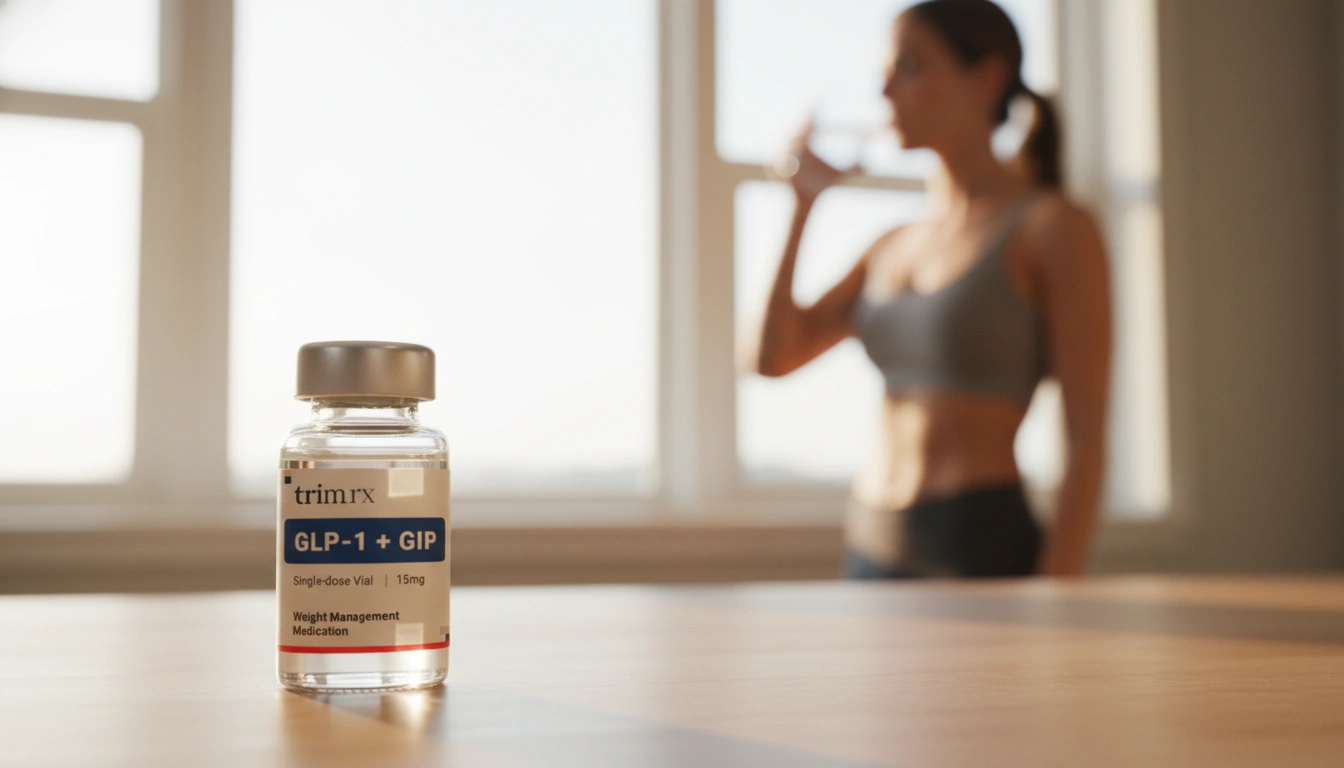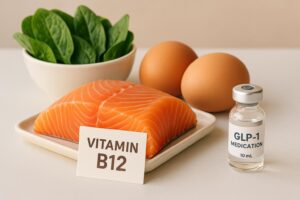Natural Ways to Boost GLP-1 for Better Metabolic Health

When it comes to the modern understanding of weight management and metabolic health, glucagon-like peptide-1 (GLP-1) has emerged as a topic of great interest. This naturally occurring hormone plays a pivotal role in regulating appetite, blood sugar levels, and overall metabolic function. Yet, many individuals remain unaware of its significance until the introduction of prescription medications that mimic its effects, such as semaglutide (Ozempic, Wegovy) and tirzepatide (Mounjaro, Zepbound). But is there a natural way to increase GLP-1 levels in our bodies?
In this blog post, we will explore the natural mechanisms behind GLP-1 production and how lifestyle and dietary choices can influence its levels. We’ll delve into the science behind this hormone, discuss how our gut health impacts its production, and offer actionable tips to help you naturally increase your GLP-1 levels. By the end of this article, you’ll gain a comprehensive understanding of GLP-1, its functions, and effective strategies to enhance your overall well-being.
Introduction
Did you know that the gut is often referred to as our “second brain”? This is not just a catchy phrase; it underscores the intricate relationship between our digestive system and our overall health, particularly in the context of hormones like GLP-1. With increasing rates of obesity and diabetes, understanding how to naturally boost GLP-1 levels has never been more relevant.
GLP-1 is released from the gut after we eat and plays a crucial role in stimulating insulin secretion, slowing gastric emptying, and reducing appetite. However, for many, especially those with obesity, GLP-1 responses may not function optimally. This situation highlights the importance of exploring natural ways to enhance GLP-1 levels through diet and lifestyle changes.
In this post, we will cover:
- The role of GLP-1 in the body and its significance in weight management.
- How diet, particularly fiber-rich foods, can naturally boost GLP-1 production.
- The relationship between gut health and GLP-1 levels.
- Practical dietary strategies and lifestyle changes to increase GLP-1.
- The importance of personalized health solutions that consider individual needs.
Together, we will embark on a journey to uncover the natural ways to increase GLP-1 and how these changes can lead to better health outcomes.
Understanding GLP-1: The Basics
Before exploring how to increase GLP-1 levels, it’s essential to understand what GLP-1 is and its functions within the body.
What is GLP-1?
GLP-1 is a hormone produced in the gut by specialized cells known as enteroendocrine cells. It is classified as an incretin hormone, which means it is released after eating and helps regulate insulin secretion from the pancreas. The main functions of GLP-1 include:
- Stimulating Insulin Secretion: GLP-1 enhances the secretion of insulin in response to meals, helping to lower blood sugar levels.
- Slowing Gastric Emptying: It slows down the rate at which food leaves the stomach, promoting a feeling of fullness.
- Reducing Appetite: GLP-1 acts on the brain to suppress appetite, leading to reduced food intake.
- Controlling Glucagon Release: It inhibits glucagon secretion, a hormone that increases blood sugar levels, thus maintaining glucose homeostasis.
Why Is GLP-1 Important?
In recent years, the attention on GLP-1 has surged due to its crucial role in managing obesity and type 2 diabetes. Studies have shown that GLP-1 receptor agonists, which mimic the action of GLP-1, can lead to significant weight loss and improved glycemic control. For many, these medications have provided an effective solution for managing weight and achieving better health outcomes.
However, relying solely on medications is not the only approach. Understanding how to naturally enhance GLP-1 production can empower individuals to take control of their health in a holistic manner.
The Connection Between Diet and GLP-1
Diet plays a critical role in the natural production of GLP-1. Research has shown that certain foods can stimulate GLP-1 secretion, making them valuable allies in the quest for optimal metabolic health.
The Role of Fiber
One of the most effective ways to boost GLP-1 levels is through dietary fiber. Fiber is not only essential for digestive health, but it also significantly impacts GLP-1 production:
-
Types of Fiber: There are two main types of dietary fiber: soluble and insoluble. Soluble fiber, found in foods like oats, beans, and fruits, is particularly effective at increasing GLP-1 levels. It forms a gel-like substance in the gut, slowing digestion and enhancing satiety.
-
Fermentable Fiber: Fermentable fibers, such as beta-glucan found in oats and barley, are broken down by gut bacteria into short-chain fatty acids (SCFAs), which can stimulate GLP-1 release.
Foods to Include in Your Diet
To naturally increase GLP-1 levels, consider incorporating the following fiber-rich foods into your meals:
- Whole Grains: Oats, barley, and brown rice are excellent sources of soluble fiber.
- Fruits and Vegetables: Apples, bananas, berries, and leafy greens provide essential vitamins and minerals while also boosting fiber intake.
- Legumes: Beans, lentils, and chickpeas are high in both protein and fiber, making them satiating and beneficial for GLP-1 production.
- Nuts and Seeds: Almonds, chia seeds, and flaxseeds are nutritious options that contribute to fiber intake.
By focusing on these foods, you can create a diet that not only supports your overall health but also enhances GLP-1 production naturally.
The Importance of Gut Health
Our gut health plays a pivotal role in the production of GLP-1. A diverse and balanced gut microbiome can enhance the secretion of this hormone, while an imbalanced microbiome can hinder its function.
How Gut Bacteria Influence GLP-1
The trillions of microorganisms residing in our gut are instrumental in breaking down dietary components, including fiber. Here’s how they contribute to GLP-1 production:
-
Short-Chain Fatty Acids (SCFAs): When gut bacteria ferment fiber, they produce SCFAs, which have been shown to stimulate GLP-1 secretion. A diet rich in fermentable fibers can support this process.
-
Indoles: Certain gut bacteria convert tryptophan (an amino acid found in many protein-rich foods) into indoles, which can boost GLP-1 levels.
-
Secondary Bile Acids: Gut bacteria can modify bile acids, influencing GLP-1 release depending on which receptors they bind to.
Strategies for Improving Gut Health
To promote a healthy gut microbiome, consider the following strategies:
-
Probiotics: These beneficial bacteria can be found in fermented foods like yogurt, kefir, sauerkraut, and kimchi. They may help enhance GLP-1 production and overall gut health.
-
Prebiotics: Prebiotic foods, such as garlic, onions, and asparagus, feed the healthy bacteria in your gut, contributing to better microbial balance.
-
Hydration: Drinking plenty of water supports digestion and the overall function of the gut microbiome.
-
Limit Processed Foods: Reducing the intake of processed and high-sugar foods can help maintain a healthy gut microbiome.
By adopting these practices, you can create an environment that fosters the growth of beneficial gut bacteria, ultimately supporting GLP-1 production.
Lifestyle Changes to Enhance GLP-1
In addition to dietary modifications, certain lifestyle changes can further support the natural increase of GLP-1 levels.
Regular Exercise
Regular physical activity has been shown to positively affect GLP-1 levels. Both aerobic and resistance training can enhance insulin sensitivity and contribute to better metabolic health. Here’s how exercise can make a difference:
-
Increased GLP-1 Secretion: Studies suggest that exercise can lead to an acute increase in GLP-1 levels, particularly after meals.
-
Weight Management: Regular exercise helps with weight loss and maintenance, which can improve GLP-1 responses over time.
Aim for at least 150 minutes of moderate-intensity aerobic exercise per week, along with strength training exercises on two or more days per week.
Stress Management
Chronic stress can negatively impact hormonal balance, including GLP-1 levels. Incorporating stress management techniques into your routine can promote better overall health:
-
Mindfulness and Meditation: Practices such as mindfulness meditation can help reduce stress and improve emotional well-being.
-
Physical Activity: Exercise is not only beneficial for physical health but also serves as a powerful stress reliever.
-
Adequate Sleep: Prioritize quality sleep, as insufficient rest can disrupt hormonal balance and impact appetite regulation.
By managing stress effectively, you can create a favorable environment for GLP-1 production.
Personalized Health Solutions
At TrimRx, we understand that each individual’s journey is unique. Our personalized weight loss solutions are designed to offer support tailored to your specific needs and goals. We believe that sustainable weight loss should be achieved through science, empathy, and a transparent approach.
Together, we can explore how our personalized programs and medically supervised care can help you on your weight loss journey. We invite you to take our free assessment quiz to determine your eligibility for our prescription weight loss medications, including GLP-1 receptor agonists.
Additionally, consider enhancing your weight loss journey with our quick-access supplements, such as:
Conclusion
Enhancing your body’s natural GLP-1 production is not only possible but essential for supporting weight management and overall metabolic health. By incorporating fiber-rich foods, maintaining a healthy gut, engaging in regular physical activity, and managing stress, you can create an environment conducive to increased GLP-1 levels.
At TrimRx, we believe in empowering individuals to embrace healthier lifestyles through personalized, medically supervised care. By focusing on natural approaches to boost GLP-1 and understanding the intricacies of your body, you can embark on a transformative journey toward better health.
As we continue to explore the connection between GLP-1, diet, and lifestyle, we encourage you to take the first step in your weight loss journey. Together, let’s work toward achieving your health goals!
FAQ
What is GLP-1?
GLP-1, or glucagon-like peptide-1, is a hormone produced in the gut that plays a critical role in regulating appetite, insulin secretion, and blood sugar levels.
How can I naturally increase GLP-1 levels?
You can naturally enhance GLP-1 levels by consuming fiber-rich foods, maintaining a healthy gut microbiome, engaging in regular exercise, and managing stress effectively.
What types of foods are best for boosting GLP-1?
Foods high in soluble fiber, such as whole grains, fruits, vegetables, legumes, nuts, and seeds, are particularly effective in boosting GLP-1 production.
How does gut health affect GLP-1 levels?
A healthy gut microbiome promotes the fermentation of dietary fibers into short-chain fatty acids, which can stimulate GLP-1 secretion. An imbalanced microbiome may hinder this process.
Are there any supplements to support GLP-1 levels?
Yes, at TrimRx, we offer quick-access supplements like GLP-1 Daily Support and Weight Loss Boost that can complement your weight loss efforts.

Transforming Lives, One Step at a Time
Keep reading
Vitamin B12 and GLP-1 Medications: What to Know
GLP-1 medications can lower B12 absorption and intake; learn symptoms, food sources, supplement options, and how to monitor levels.
Semaglutide Injection Site Reactions: What To Know
Learn why semaglutide injections can cause redness, swelling or nodules, how to prevent and treat them, and when to seek medical care.
TrimRx vs Friday’s
Compare TrimRx and Friday’s telehealth GLP-1 weight-loss programs: pricing, medical support, coaching, delivery, and which fits your needs.



